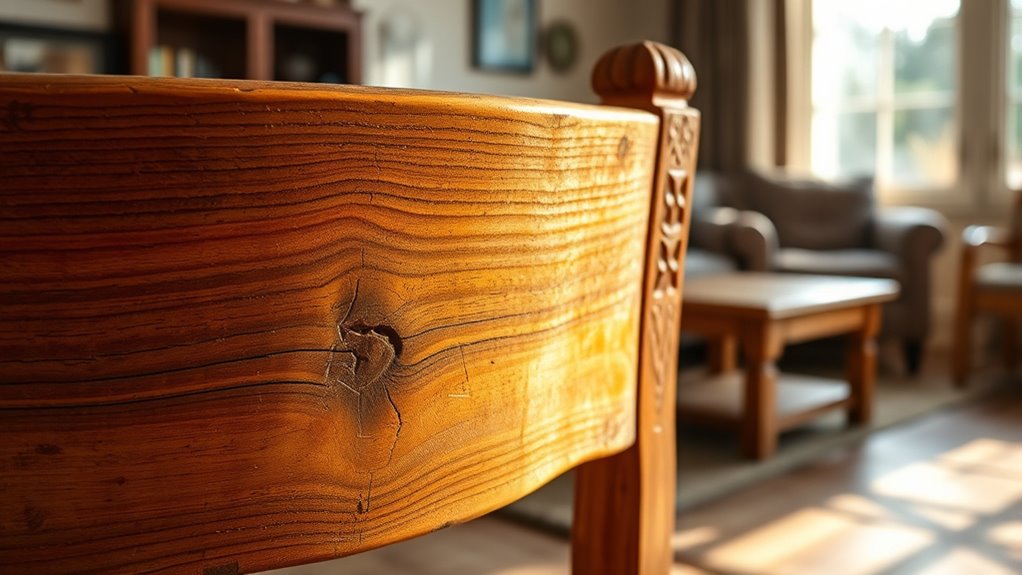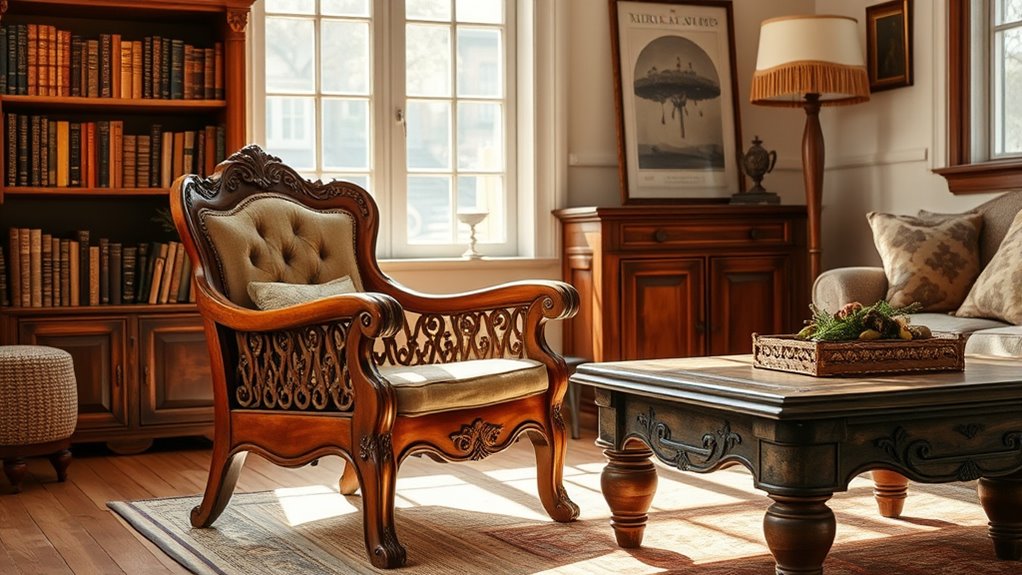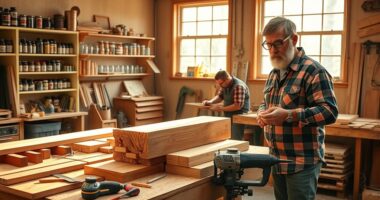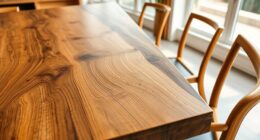Vintage wood furniture is making a strong comeback in home décor, thanks to its timeless charm and natural appeal. You’ll notice warm, textured finishes, dark woods like walnut and mahogany, and styles inspired by Art Deco and Art Nouveau. People are also drawn to its sustainability, as these pieces promote reuse and eco-friendly living. If you keep exploring, you’ll discover how this classic trend blends history with contemporary design for a unique, inviting space.
Key Takeaways
- Vintage wood furniture’s timeless charm and natural character continue to enhance modern home interiors.
- Dark woods like walnut and mahogany are making a stylish comeback, adding depth and sophistication.
- Revival of styles such as Art Deco and Art Nouveau introduces elegance and historical appeal to contemporary spaces.
- Trends favor natural materials, warm earth tones, and handcrafted accents, emphasizing authenticity and organic aesthetics.
- Sustainable practices, including reuse and eco-friendly finishes, boost vintage furniture’s popularity in eco-conscious décor.

Have you ever wondered why vintage wood furniture continues to captivate homeowners today? It’s because these pieces bring a timeless charm that’s hard to replicate with modern designs. The natural grain and character inherent in vintage wood highlight authenticity, making each piece feel unique and rooted in history.
People are increasingly drawn to the organic appeal of natural materials like cotton, wool, and Belgian linen, which perfectly complement vintage wood furnishings. These textiles, along with handcrafted wool rugs and natural stone accents, create warm, textured environments that evoke comfort and sustainability. Incorporating natural materials can elevate the cozy, authentic feel of a farmhouse bedroom.
Natural textiles like linen, wool, and cotton enhance vintage wood’s warmth, creating cozy, sustainable interiors.
The soft, rounded shapes favored in 2025 furniture trends further enhance this aesthetic, giving vintage pieces a gentle, organic look that feels inviting and harmonious. This shift toward softer forms and natural materials aligns with the growing emphasis on healthy living, prompting more homeowners to incorporate sustainable, natural décor elements.
Dark wood furniture, in particular, is making a significant comeback. Rich species like walnut, mahogany, and rosewood are gaining popularity because of their deep hues and striking visual impact. These dark pieces provide a bold contrast against lighter modern color palettes, adding depth and sophistication to interiors.
Restoration efforts help preserve the charm and value of traditional dark wood antiques, allowing homeowners to enjoy their beauty for years. Mixing these pieces with contemporary art or fine porcelain creates a fresh, balanced aesthetic that feels both vintage and modern.
As designers and homeowners seek versatile elements, dark wood furniture’s appeal continues to grow, proving its timelessness and adaptability.
Meanwhile, styles from the past, especially Art Nouveau and Art Deco, are being reintroduced into modern interiors. Their intricate details and bold aesthetics add a layer of elegance and historical depth to vintage collections.
Art Deco’s geometric forms and Art Nouveau’s flowing lines influence new designs, blending old-world charm with contemporary sensibilities in 2025. This mix of styles encourages individuality in home décor, allowing you to create spaces that reflect your personal taste while honoring tradition.
Vintage dealers report a rising interest in these styles, indicating a renewed appreciation for their unique appeal.
Color palettes and finishes also play a role in this resurgence. Warm earth tones and muted hues dominate vintage-inspired décor, enhancing the natural beauty of wood furniture.
Finishes range from polished and lacquered to subtly distressed, adding character and authenticity. Unexpected textures, such as matte or textured surfaces, are gaining popularity, allowing for creative layering of colors and materials that foster cozy, nostalgic atmospheres.
Additionally, incorporating sustainable materials in vintage furniture supports environmentally conscious living and enhances its timeless appeal.
Research shows that using eco-friendly materials can significantly reduce the environmental impact of furniture production, making vintage pieces an even more attractive choice for sustainable lifestyles.
Ultimately, vintage wood furniture isn’t just about aesthetics; it’s also about supporting sustainable living. Each piece’s individual character and craftsmanship make it a meaningful addition to your home, promoting reuse and reducing environmental impact.
This sustainable approach, combined with the allure of history and craftsmanship, keeps vintage wood furniture relevant and highly sought after today.
Conclusion
As you embrace vintage wood furniture, you blend the charm of history with modern style. The worn edges and rich grains tell stories that sleek, new pieces can’t match, offering warmth in a world dominated by mass production. While technology advances and minimalism takes hold, your vintage finds stand as timeless reminders of craftsmanship. In choosing these pieces, you create a space that’s both nostalgic and fresh—a perfect juxtaposition of past and present, comfort and style.









